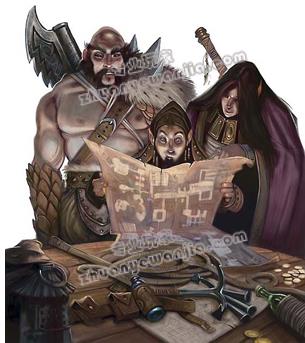美服《龙与地下城》规则更新说明 力求更好的游戏体验
规则更新
我们继续为努力D&D Next的发布努力着,所以大家在公共游戏测试中看到一些规则正在进行修订。快速浏览部分更新和变化。
探索
探索规则已经重新设计,旨在更便于使用。我们重新启用第四版的被动感知概念,减少死亡数量,加速游戏进程。角色的被动感知是在智慧(感知)检查上滚动10次的结果。你的角色表上将有一个空间来记录这一点。
我们也将探索系统的基础调入团队前进秩序。当团队走进某个陷阱,隐藏的怪物或其他威胁, DM就会使用行军顺序和被动感知来决定谁去解决威胁。这种变化可以消除跟踪团队警觉性,虽然快速移动会降低角色的被动感知。

我们也简化了队伍秘密行动的概念。只要团队行动缓慢,队里每个人就都会隐藏灵巧度(隐形)检查,除了行进时他们所采取的其他行动。缓慢行动, 盗贼就可以在撬锁或寻找隐秘门时隐藏起来。当队伍加快速度,他么依旧可以隐藏,只是每个角色都需要采取某些行动。
包括检查随机遭遇在内的序列的概念依然保留。你仍然可以在探险的时候做多个任务,但我们对这些有了较统一的规定。例如,行动如狩猎或潜行现在都有了适当的能力描述。探索规则简单地将他们解释为你在探索时要做的事。
最后,我们制订了完成特定行动所需要的世间。解除陷阱或挑选锁需要1分钟, 这样就使得他可以匹配探索过程,且便于DM计时 。
额外的行动
游戏性测试过程表明,在战斗中获得额外的行动可以导致很多强大的组合。此外,角色叠加到额外的行动会使得游戏陷入困境。多职业系统为解决这个问题提供了方案,角色可以融合多个职业的特征和能力。
现在,我们正在制定另一个规则,即每轮每个角色只能有一次额外行动,然后在适当的地方标记能力。该规则的目的是为了避免叠加选择,诸如双武器战斗,盗贼狡猾的行动,武僧极速连击, 切换法术, 吟游诗人的灵感和其他能力。
角色速度和重甲
我们赋予所有标准玩家角色种族30英尺的速度, 并允许具有足够强度分的玩家可以忽略重甲带来的速度减少。
对较小的角色和矮人的速度惩罚并会将他们跟其他种族区分开来。此外,自第三版发布,妖精和狗头人有30英尺的速度,所以在某种程度上,我们只是调整侏儒,半精灵,矮人的现有标准。
至于护甲,我们想要重甲存在某些潜在的缺陷而不会过于严苛。重甲很重, 因此你的力量在其有效性上发挥作用是显而易见的。这种变化使得中型盔甲对力量和尽皆醒都不高的角色来说尤为重要。其他角色仍然可以最大化他们的AC,如果他们的敏捷性也很低的话,但代价是如果力量值低于13,那它的速度聚会降低10英尺。游戏工作室联盟首选专业玩家网,集合所有网游项目,游戏辅助,等游戏赚钱方法。
原文
A Few Rules Updates
As we continue to work toward the release of D&D Next, a number of rules that you saw in the public playtest have undergone revision. Here's a quick look at some of those updates and changes.
Exploration
The exploration rules have been reworked to make them easier to use at the table. We've brought back the concept of passive perception from 4th Edition to cut down on the number of die rolls and to speed up play. A character's passive perception is the result of rolling 10 on a Wisdom (Perception) check. Your character sheet will have a space to note this, making it a value you calculate once and then use as needed.
We've also folded the basics of the exploration system into the party's marching order. As the party approaches a trap, a hidden monster, or some other threat, the DM uses a combination of marching order and passive perception to determine who sees the threat and when. This change eliminates tracking the party's alertness, though moving at a fast pace imposes a penalty to characters' passive perception.
We also simplified the concept of group stealth. Whenever the party moves at a slow pace, everyone in the group makes Dexterity (Stealth) checks to hide, in addition to whatever other actions they take while traveling. At a slow pace, a rogue can thus attempt to hide while using an action to pick a lock or search for secret doors. If the party moves at a faster pace, each character can still attempt to hide, but must use an action to do so.
The idea of a sequence that includes checking for random encounters remains in place. You can still undertake a variety of tasks while exploring, but we've unified those options with the general rules for doing stuff. For instance, actions such as hunting or sneaking are described under their appropriate abilities. The exploration rules simply reference them as things you might do while exploring.
Finally, we've standardized the time it takes to complete certain actions with the exploration rules. Disarming a trap or picking a lock takes 1 minute, matching the duration of an exploration round in the dungeon and making timekeeping easier for the DM.
Extra Actions
The playtest process showed us that gaining an extra action on your turn in combat can lead to a lot of overpowered combinations. In addition, letting characters stack up extra actions can seriously bog down the game. Multiclassing cast a bright light on this issue, with characters combining class features and swift spells on the same turn to unleash all sorts of havoc.
Right now, we're working with a rule that limits a character to one bonus action per turn, and then labeling abilities as bonus actions where appropriate. The goal of this rule is to avoid stacking up options like two-weapon fighting, the rogue's Cunning Action, the monk's Flurry of Blows, swift spells, Bardic Inspiration, and other abilities
Character Speed and Heavy Armor
We're looking at giving all the standard player character races a speed of 30 feet, and allowing characters with sufficient Strength scores to ignore the speed penalties for heavy armor. We think these ideas make sense for a few different reasons.
The speed penalty for smaller characters and dwarves doesn't differentiate them from the other races in any interesting way. Moreover, goblins and kobolds have had a speed of 30 feet since the days of 3rd Edition, so in some ways, we're simply adjusting gnomes, halflings, and dwarves to an existing standard.
When it comes to armor, we wanted heavy armor to have potential drawbacks without being overly harsh or restrictive. Heavy armor is . . . well, heavy, so making your Strength play a role in its effectiveness is intuitive. This change allows medium armor to play a more meaningful role for characters with marginal Strength and Dexterity scores. Other characters can still maximize their AC with heavy armor if they have a poor Dexterity, but at the cost of reducing speed by 10 feet if a character's Strength is less than 13.